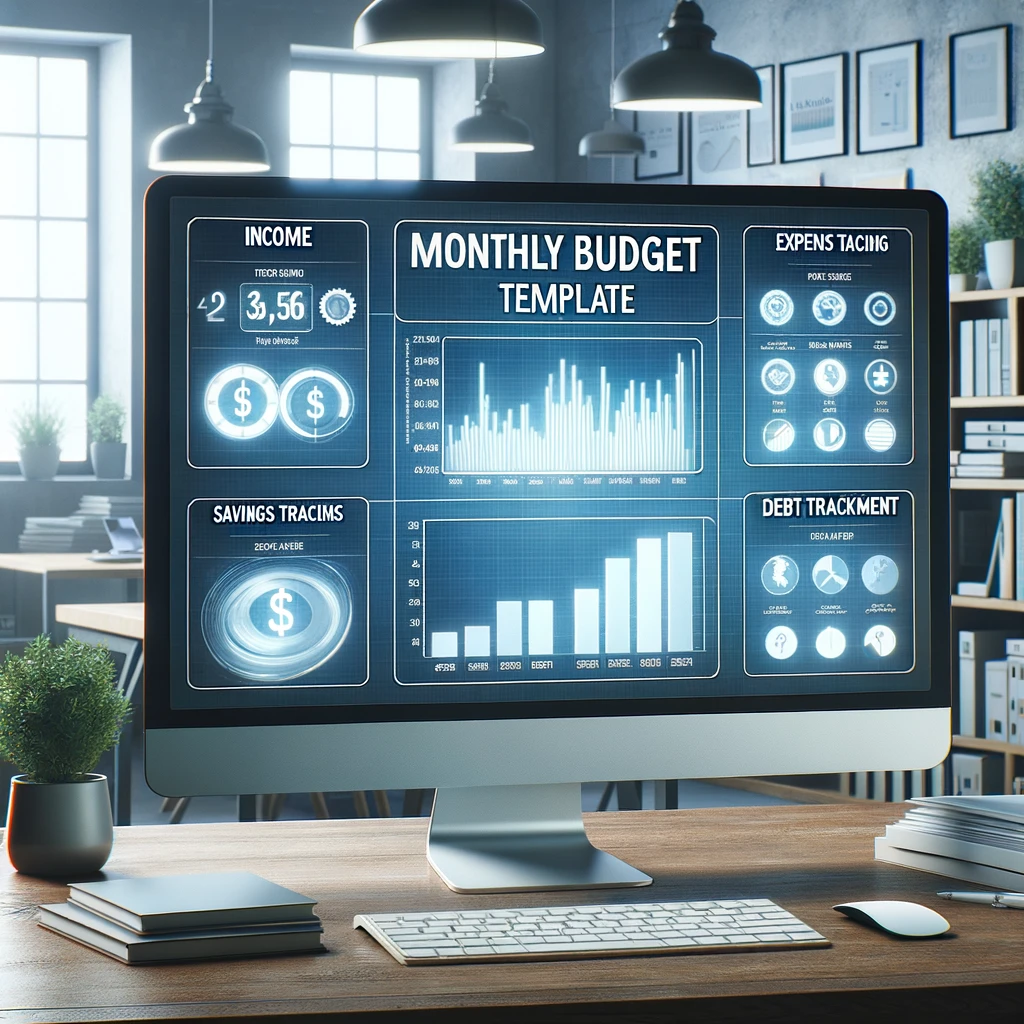Table of Contents
Introduction
Navigating the world of personal finance can be a daunting task.
Understanding where your money goes each month is crucial.
That’s where monthly budget templates come into play.
These tools provide a structured way to track income and expenses. They help you gain control over your financial life.

In this comprehensive guide, we delve into the importance of these templates. We explore how they aid in effective financial planning.
We’ll compare digital and paper budget planners. We’ll discuss how to choose the right one for your unique financial situation.
Whether you’re a financial advisor or an individual seeking to improve your financial management skills, this guide is for you.
Join us as we unravel the intricacies of monthly budget templates and their role in achieving financial goals.
The Importance of Monthly Budget Templates in Financial Planning
Monthly budget templates are more than just tools. They are the foundation of sound financial planning.
They provide a clear picture of your income and expenses. This visibility is key to managing your finances effectively.
A well-structured budget template helps you identify spending patterns. It reveals areas where you can cut back and save more.
It also aids in setting realistic financial goals. Whether it’s saving for a vacation, paying off debt, or planning for retirement, a budget template can guide you.
Here are some key benefits of using monthly budget templates in financial planning:
- Debt Management: They help you keep track of your debts and plan for repayments.
- Savings Goals: They allow you to allocate funds towards your savings goals each month.
- Expense Tracking: They provide a detailed breakdown of your spending, helping you identify areas for cost reduction.
- Financial Awareness: They increase your financial literacy, giving you a better understanding of your financial situation.
Moreover, budget templates instill discipline. They encourage you to stick to your financial plan and avoid impulsive spending.
In essence, monthly budget templates are indispensable for effective financial planning. They empower you to take control of your financial future.
In the following sections, we’ll delve deeper into how to choose and use these templates effectively.
Digital vs. Paper: Choosing the Right Monthly Budget Template
Choosing the right monthly budget template is crucial. It should align with your lifestyle and financial goals.
There are two main types of budget templates: digital and paper. Both have their unique advantages.
Digital budget templates are convenient and easily accessible. They offer automated calculations, saving you time and reducing errors.

by Firmbee.com (https://unsplash.com/@firmbee)
Many digital templates also provide visual aids. These can help you better understand your financial situation.
On the other hand, paper budget templates offer a tactile experience. Some people find this more engaging and easier to stick with.
In the end, the choice between digital and paper depends on your personal preference. Choose the one that you’re most comfortable with and can commit to using regularly.
Key Features of Effective Monthly Budget Templates
Effective monthly budget templates share certain key features. These features make them more user-friendly and efficient.
Firstly, they should be simple and easy to understand. A complex template can be discouraging and hard to maintain.
Secondly, they should be customizable. Everyone’s financial situation is unique, so a one-size-fits-all approach won’t work.

Here are some key features to look for:
- Income Tracking: The template should have a section to record all sources of income. This includes salaries, bonuses, and any other income.
- Expense Tracking: It should allow you to record all your expenses. This includes both fixed and variable expenses.
- Savings and Investment Tracking: The template should have a section for tracking savings and investments. This helps you monitor your progress towards financial goals.
- Debt Tracking: If you have loans or credit card debt, the template should allow you to track these.
- Visual Aids: Graphs and charts can help you visualize your financial situation. They can make it easier to understand where your money is going.
Remember, the best monthly budget template is the one that works for you. It should align with your financial goals and be easy for you to use and maintain.
Step-by-Step Guide to Filling Out Your Monthly Budget Template
Filling out a monthly budget template can seem daunting at first. However, with a step-by-step approach, it becomes manageable.
The first step is to gather all your financial information. This includes your income details, expense receipts, and bank statements.
Next, input your income into the template. This should include all sources of income, such as salary, bonuses, and any other earnings.

Then, list all your fixed expenses. These are costs that remain the same each month, like rent or mortgage payments, utilities, and insurance premiums.
After that, record your variable expenses. These are costs that can change from month to month, like groceries, entertainment, and personal care items.
Now, it’s time to track your savings and investments. If you have a specific savings goal, make sure to include it in this section.
Next, if you have any debts, record them in the debt tracking section. This includes credit card debt, student loans, and any other liabilities.
At this point, you should have a clear picture of your income, expenses, savings, and debts. Now, it’s time to analyze this information.
Look for areas where you can cut back on spending. This could be unnecessary subscriptions or dining out too often.
Also, look for ways to increase your income. This could be asking for a raise, starting a side hustle, or investing in income-generating assets.
Finally, review your budget regularly. This will help you stay on track and make necessary adjustments as your financial situation changes.
Remember, the goal of a monthly budget template is not to restrict your spending. Instead, it’s to give you control over your finances and help you achieve your financial goals.
Customizing Your Monthly Budget Template for Unique Financial Needs
A monthly budget template is not a one-size-fits-all tool. It should be customized to fit your unique financial needs and goals.
Start by identifying your financial priorities. These could be paying off debt, saving for a home, or investing for retirement.
Next, adjust the categories in your budget to reflect these priorities. For example, if you’re saving for a home, you might want to include a category for “Home Savings”.
Also, consider your lifestyle when customizing your budget. If you love to travel, make sure to include a category for “Travel Expenses”.
Remember, the goal of a budget is not to restrict your spending. It’s to help you spend your money in a way that aligns with your values and goals.
So, don’t be afraid to make your budget template your own. After all, it’s a tool designed to help you, not hinder you.
Consistency and Accuracy: Strategies for Monthly Budget Template Success
Consistency is key when it comes to using a monthly budget template. It’s not enough to fill it out once and forget about it.
You should be updating your budget regularly, ideally every time you make a financial transaction. This will ensure that your budget accurately reflects your spending habits.
Accuracy is also crucial. Make sure to record all your expenses, no matter how small. These small expenses can add up over time and throw off your budget.
Don’t forget to account for irregular expenses as well. These are expenses that don’t occur every month, like car repairs or annual insurance premiums.
By being consistent and accurate with your budgeting, you can gain a clear picture of your financial situation. This will help you make informed decisions about your spending and saving habits.
The Long-Term Impact of a Well-Maintained Budget
A well-maintained budget can have a profound impact on your long-term financial health. It can help you build wealth over time by enabling you to save and invest more effectively.
By keeping track of your income and expenses, you can identify areas where you can cut back. This can free up more money for savings and investments.
A budget also helps you avoid debt or pay it off faster. By knowing exactly where your money is going, you can make sure it’s not being wasted on unnecessary expenses.
In short, a well-maintained budget is a powerful tool for achieving financial freedom.
Incorporating Savings and Investments into Your Monthly Budget
A comprehensive monthly budget template should include a section for savings and investments. This is crucial for long-term financial planning.
Allocating a portion of your income to savings helps build an emergency fund. This fund can be a lifesaver during unexpected financial crises.
Investments, on the other hand, are your ticket to wealth accumulation. They can provide a source of passive income and help you achieve financial independence.
In conclusion, a well-rounded budget should account for both savings and investments. This ensures a balanced approach to managing your finances.
Adjusting Your Budget: Dealing with Setbacks and Unexpected Expenses
Budgeting is not a set-it-and-forget-it process. It requires regular adjustments to accommodate changes in your financial situation.
Unexpected expenses are a common reason for budget adjustments. These could be medical bills, car repairs, or sudden travel expenses.
When such expenses arise, it’s important not to panic. Instead, revisit your budget and make necessary adjustments.
This might mean cutting back on discretionary spending or dipping into your emergency fund. Remember, the goal is to maintain financial stability.
Setbacks, such as a job loss or a pay cut, also necessitate budget adjustments. In such cases, focus on reducing non-essential expenses and prioritizing basic needs.
In conclusion, a flexible budget is a resilient budget. It allows you to navigate financial challenges without derailing your long-term financial goals.
Master Your Finances: Explore the Benefits of Our Monthly Budget Template
In our comprehensive guide to personal finance, we’re excited to offer an exceptional monthly budget template designed to streamline the way you manage your finances. With our easy-to-use template, you can meticulously track your income and expenses, ensuring that every dollar is accounted for. This tool is not just about keeping records; it’s about empowering you to make informed financial decisions, reduce unnecessary spending, and bolster your savings efforts.
Whether you’re aiming to manage debt, save for future goals, or simply gain a clearer understanding of your financial landscape, our monthly budget template is the perfect companion in your journey to financial clarity and control. Explore the benefits today and take the first step towards a more organized financial future.
Click Here To get your Monthly Budget Template
Conclusion: The Role of Monthly Budget Templates in Achieving Financial Goals
Monthly budget templates are more than just financial tools. They are roadmaps to achieving your financial goals.
By providing a clear picture of income and expenses, they enable informed financial decisions. They also foster discipline and consistency in financial management.
In essence, a well-maintained budget is a stepping stone to financial freedom. It empowers you to take control of your finances and steer them in the direction of your goals.
In conclusion, the journey to financial success begins with a simple step: adopting a monthly budget template.




Leave a reply